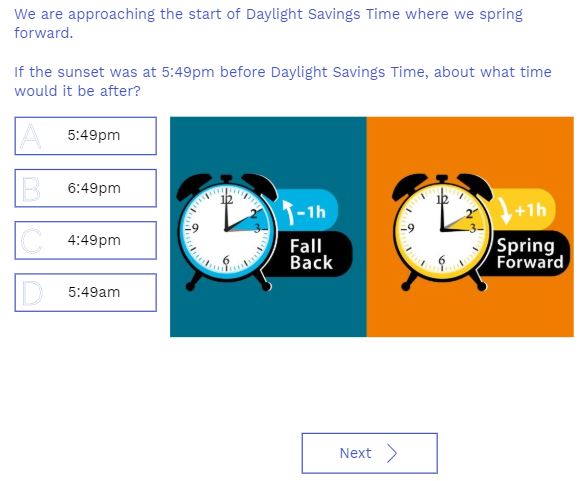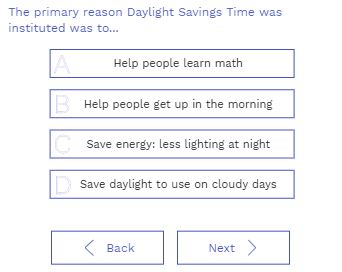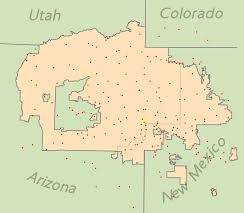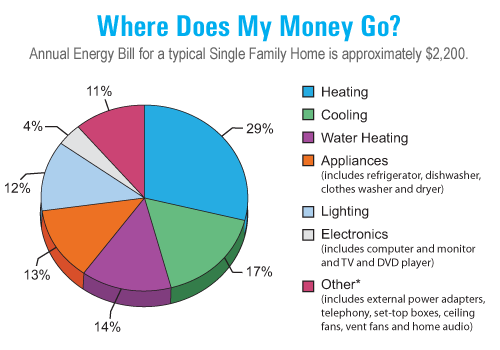We created an activity to help your students learn about Daylight Savings Time. Students work on connected devices to answer Daylight Savings Time trivia and math questions. With all 7 questions this would be a great 25-30 minute activity. If that’s too long, you could cut the 5th and 7th problems and make it a 10 minute warm-up.
The activity starts with a simple question to remind them what Daylight Savings Time is. Students estimate how the spring time change will affect when the sun sets. This seemingly simple problem might be harder for some students than you think. You can always remind them that they are about to “spring forwards” because daylight savings time is about to begin.

– Task 1: Spring Forward Fall Back –
The next task tells students that Daylight Savings Time lasts for 34 weeks. It asks them what percentage of the year this is. Some of your students may need a reminder that there are 52 weeks in the year. As a challenge, you could ask them how many days in the year and make them compute the number of weeks with the scratchpad calculator. It is always good to show your work; students make fewer errors and teachers can see their thought process. That’s why we encourage use of the scratchpad (plus, it is fun to share the student work with the class, and even ask for volunteers).
Task 3 presents some trivia relating to Daylight Savings Time. According to Wikipedia, it was first started as a way to save energy used on lighting. If the sun sets later in the day, people do not need to turn the lights on until later. The goal was to best align when people would be awake with when the sun would be up.

– Task 3: Daylight Savings Time History –
Did you know that Arizona and Hawaii do not observe Daylight Savings Time? If you did then you could correctly answer the next task. Students are asked to tap one of the two states on the map that do not observe Daylight Savings Time. When you review this task, feel free to add in a fun anecdote about why Hawaii does not change their clocks. (Hint: they are closer to the equator, making their winter and summer sunset times more similar than in other states. Interesting!) So why not Arizona? You’ll have to read on because task 7 is about why Arizona doesn’t observe Daylight Savings Time.
The next task asks students to compare sunset times between Colorado and Arizona during daylight savings time. You may need to remind students that Daylight Savings Time happens during the summer. In the Winter, Colorado and Arizona both have the same time.
Task 6 explores the interesting fact that the Navajo Nation recognizes Daylight Savings Time while Arizona does not. During Daylight Savings Time, (spring through fall) the Navajo Nation has the same time as Utah, New Mexico and Colorado but a different time from Arizona. For this task, students are asked to sketch a route on the map to show where they would have to change the clock 5 times without turning around. To get 2 clock changes, students draw a line that goes from Arizona to the Navajo Nation (or one of the other states) and back to Arizona. They then need to do this again, ending with one final trip to the Navajo Nation. In the winter, the entire map is on Western Standard Time so there would not be any clock changes necessary.

– Task 6: The Navajo Nation –

– Task 7: Home Energy Use by Sector –
This task gets students thinking critically about how the timing of the sunset relates to home energy use. Students share ideas with a partner and one of them writes their answer on the scratchpad. There are also hints on the scratchpad.
We recommend this activity as a review of Daylight Savings Time or as a fun warm-up just before or after we change the clocks. To preview the activity, click the link below. Or, login to wootmath.com and search for “Daylight Savings Time” in the Shared Gallery.
Preview Daylight Savings Time Trivia
Visit our page on Formative Assessment for more on how to use this free tool in your classroom.


